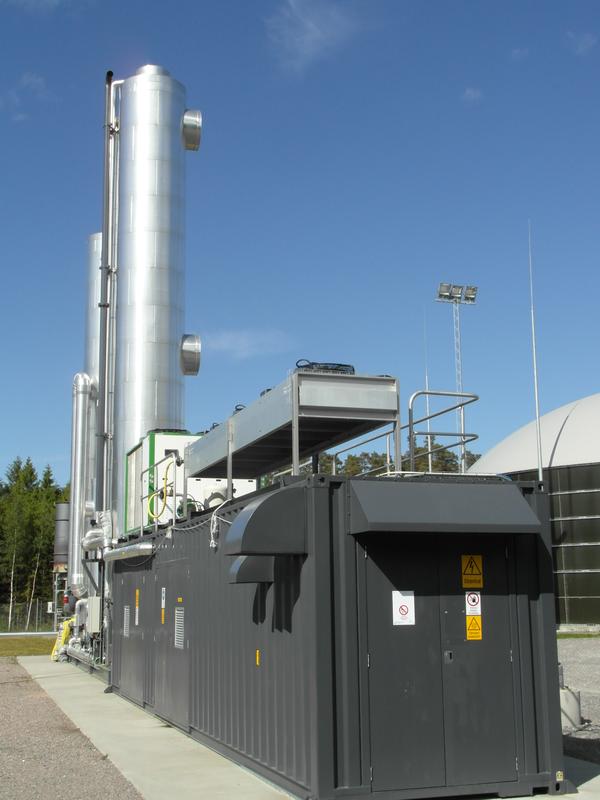Organic waste into biomethane: Concepts for five European cities

Biogas processing plant in Lidköping, Sweden © Fraunhofer IWES
Mr. Hoffstede, group manager responsible for Biogas Plant Technology at IWES, stated „Biogas production from waste materials is a trendsetting technology that helps to solve waste problems in urban areas and is a great tool to help reach the EU 2020 targets”.
The UrbanBiogas project is supported by the Intelligent Energy for Europe Programme of the European Commission. The objective of the project is to promote the use of organic urban waste for biogas production, to develop individual and feasible Waste to Biomethane (WtB) plant concepts for the 5 European cities participating in the project: Abrantes (Portugal), Gydnia (Poland), Graz (Austria), Zagreb (Croatia) und Valmiera (Latvia).
„The biogas production and upgrading technology is available and operates reliably”, says the IWES expert for biogas upgrading and grid injection, Michael Beil.
Reliable Biogas Upgrading Technology
The employees of the responsible companies for energy and waste management in each of the five participating cities were trained by Fraunhofer IWES experts within the UrbanBiogas project. The training comprises not only technical biogas production and upgrading concepts but also project financing as well as a basic understanding of the whole biomethane value chain. “Together with the working groups of our project partners we could develop WtB concepts which will profit from the organic waste potential by being economically feasible”, concluded Mr. Beil at the end of the triannual project.
Partner cities in Portugal, Poland, Austria, Croatia and Latvia
All five partner cities will put the developed concepts into practice in the near future, which will be a valuable contribution to climate protection and to achieving the European targets for renewable energies. The Latvian city Valmiera for example will start to implement a biogas plant this year for € 1.5 million. The target is to use both the annual 7,000 tons of organic waste and 3,000 tons of green waste energetically for biogas production instead of composting it. The estimated produced energy of 3,000 MWh will meet the electricity demand of 800 private households.
European Biomethane Workshop informs about the project findings
Fraunhofer IWES experts share the findings of UrbanBiogas and discuss the project together with other European experts during today´s „European Biomethane Workshop“. Focus is also put on the development of the European biomethane market, its value chain and the efficient use of biomethane in the European Union. “German biogas plant manufacturers are searching for new markets to promote their technologies in Europe since the German biomethane market is currently declining.”, so M. Beil Fraunhofer IWES. Besides the outcome of the project UrbanBiogas, the results of two more projects „GreenGrasGrids“ and „Biomaster“ are discussed within the workshop.
Project page „UrbanBiogas“ http://www.urbanbiogas.eu/
Event page: http://european-biogas.eu/events/biomethane-workshop/
Contact person Fraunhofer IWES:
Dipl.-Ing. Uwe Hoffstede
Group manager Biogas plat technology
+49 561 7294-438
uwe.hoffstede@iwes.fraunhofer.de
Dipl.-Ing. Michael Beil
Group manager Gas upgrading, injection and grids
+49 561 7294-421
michael.beil@iwes.fraunhofer.de
Media Contact
All latest news from the category: Power and Electrical Engineering
This topic covers issues related to energy generation, conversion, transportation and consumption and how the industry is addressing the challenge of energy efficiency in general.
innovations-report provides in-depth and informative reports and articles on subjects ranging from wind energy, fuel cell technology, solar energy, geothermal energy, petroleum, gas, nuclear engineering, alternative energy and energy efficiency to fusion, hydrogen and superconductor technologies.
Newest articles

Superradiant atoms could push the boundaries of how precisely time can be measured
Superradiant atoms can help us measure time more precisely than ever. In a new study, researchers from the University of Copenhagen present a new method for measuring the time interval,…

Ion thermoelectric conversion devices for near room temperature
The electrode sheet of the thermoelectric device consists of ionic hydrogel, which is sandwiched between the electrodes to form, and the Prussian blue on the electrode undergoes a redox reaction…

Zap Energy achieves 37-million-degree temperatures in a compact device
New publication reports record electron temperatures for a small-scale, sheared-flow-stabilized Z-pinch fusion device. In the nine decades since humans first produced fusion reactions, only a few fusion technologies have demonstrated…





















